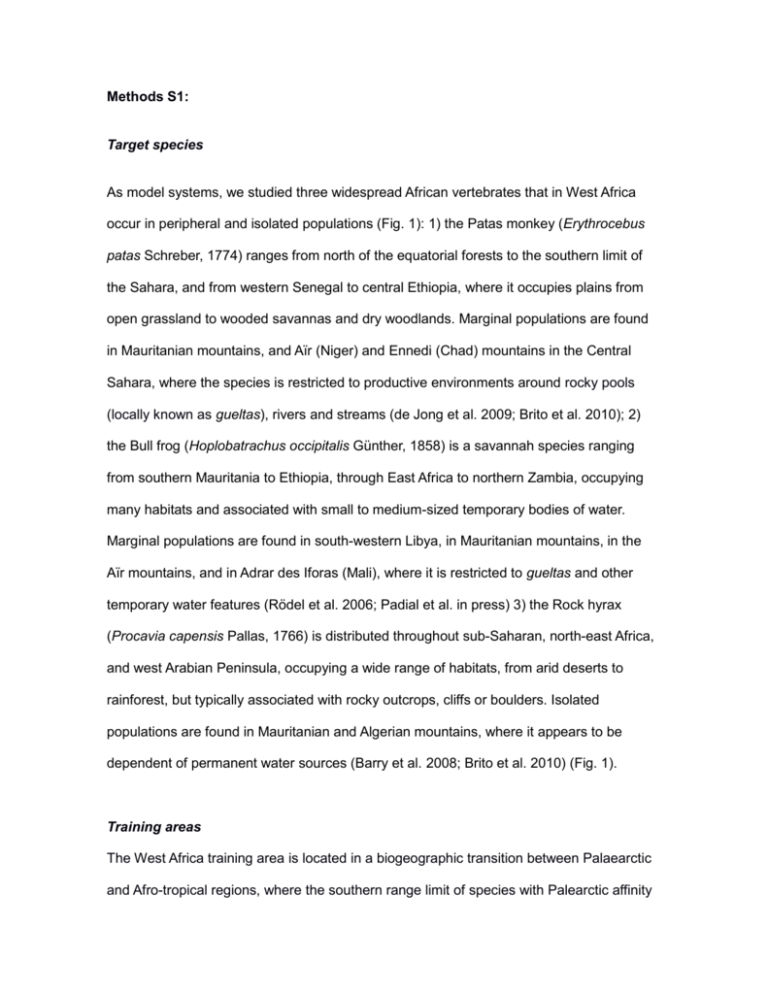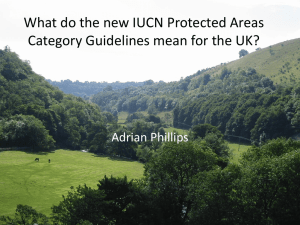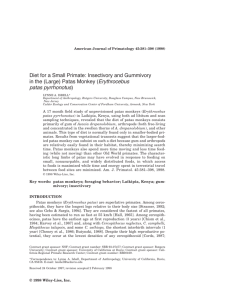ddi12115-sup-0004-MethodS1
advertisement

Methods S1: Target species As model systems, we studied three widespread African vertebrates that in West Africa occur in peripheral and isolated populations (Fig. 1): 1) the Patas monkey (Erythrocebus patas Schreber, 1774) ranges from north of the equatorial forests to the southern limit of the Sahara, and from western Senegal to central Ethiopia, where it occupies plains from open grassland to wooded savannas and dry woodlands. Marginal populations are found in Mauritanian mountains, and Aïr (Niger) and Ennedi (Chad) mountains in the Central Sahara, where the species is restricted to productive environments around rocky pools (locally known as gueltas), rivers and streams (de Jong et al. 2009; Brito et al. 2010); 2) the Bull frog (Hoplobatrachus occipitalis Günther, 1858) is a savannah species ranging from southern Mauritania to Ethiopia, through East Africa to northern Zambia, occupying many habitats and associated with small to medium-sized temporary bodies of water. Marginal populations are found in south-western Libya, in Mauritanian mountains, in the Aïr mountains, and in Adrar des Iforas (Mali), where it is restricted to gueltas and other temporary water features (Rödel et al. 2006; Padial et al. in press) 3) the Rock hyrax (Procavia capensis Pallas, 1766) is distributed throughout sub-Saharan, north-east Africa, and west Arabian Peninsula, occupying a wide range of habitats, from arid deserts to rainforest, but typically associated with rocky outcrops, cliffs or boulders. Isolated populations are found in Mauritanian and Algerian mountains, where it appears to be dependent of permanent water sources (Barry et al. 2008; Brito et al. 2010) (Fig. 1). Training areas The West Africa training area is located in a biogeographic transition between Palaearctic and Afro-tropical regions, where the southern range limit of species with Palearctic affinity meets with the northern range limit of species with Afro-tropical affinity (Dekeyser and Villiers 1956; Barry et al. 1987; Brito et al. 2010; Isenmann et al. 2010). There is a cool, dry season from November to February and a hot, dry season from March to June (Cooper et al. 2006). Annual average temperature ranges from 20.4 ºC in coastal Southern Morocco to 30.8 ºC in Western Mauritania (Hijmans et al. 2005). There is a marked north-south gradient in annual precipitation, from 11 mm in the north-eastern desert areas to 1334 mm in the extreme southern region (Hijmans et al. 2005). Rain falls in a single wet season from July to October, with most precipitation in August and September (Cooper et al. 2006). Most of the study area is covered by sandy, stony and bare deserts (30.0%, 17.9%, 10.0%, respectively; Bicheron et al. 2008), but croplands and mosaics cropland/vegetation (17.6%), and close to open shrublands and grasslands (11.8%) are more frequent in southern regions. The region is characterised by a latitudinal gradient in climate and habitat (Anyamba &Tucker 2005). This gradient is disrupted by mountains, which are characterised by a mix of both Mediterranean and Tropical climates (Le Houérou 1997) and provide suitable habitats for otherwise absent widespread African species. Species data For Africa dataset, observations were randomly selected from a cluster of species occurrences and two datasets were built: 214 observations for training and testing and another with 134 observations for validating models (Table S1 in Supporting Information). In both training and validation datasets, clustering of observations was decreased by randomly removing localities that were clustered according to the Nearest Neighbour Index (NNI) given by ArcGIS 9.3: 0.88 (p=0.07) and 0.83 (p=0.08) in E. patas, 0.92 (p=0.15) and 0.88 (p=0.05) in H. occipitalis, and 0.88 (p=0.06) and 0.82 (p=0.05) in P. capensis for the training and validation datasets, respectively. We followed the same methodology for West African data. Observations were randomly selected from a cluster of species occurrences and two datasets were built: 101 observations for training models and another with 41 for validating models (Table S1 in Supporting Information). The clustering of observations was decreased in both datasets by randomly removing clustered localities, according to NNI: 0.91 (p=0.29) and 2.70 (p=0.00) for E. patas, 0.92 (p=0.32) and 0.88 (p=0.26) for H. occipitalis, and 0.86 (p=0.22) and 1.75 (p=0.00) for P. capensis for training and validation datasets, respectively. To quantify prediction biases in ENMs, we randomly generated a pseudo-absence dataset, with the same number of observations used in the training datasets. Pseudo-absences (hereafter absences) likely corresponded with true absences because they were selected from areas outside buffers encompassing the IUCN polygons of species distribution (IUCN, 2011) and the presence dataset of each species. The buffer sizes were set according to study areas: 1) 100km around IUCN polygons of species distribution for Africa; and 2) 10km around the observations of H. occipitalis and P. capensis and 40km around E. patas observations in West Africa. Buffer size in West Africa was set according to home range size estimations, which were larger for E. patas (Isbell & Chism, 2007). References: Anyamba, A. &Tucker, C.J. (2005). Analysis of Sahelian vegetation dynamics using NOAAAVHRR NDVI data from 1981–2003. Journal of Arid Environments, 63, 596-614. Barry,J.P. et al. (1987). Le problème des divisions bioclimatiques et floristiques au Sahara. Note VI: entre Sahel et Sahara: l'Adrar mauritanien. Approches biogéographique et géomorphologique. Ecol. Medit., 13, 131-181. Brito, J.C., Álvares, F., Martínez-Freiría, F., Sierra, P., Sillero, N. & Tarroso, P. (2010) Data on the distribution of mammals from Mauritania, West Africa. Mammalia, 74, 449–455. Cooper, A., Shine, T., McCann, T. & Tidane, T.A. (2006) An ecological basis for sustainable land use of Eastern Mauritanian wetlands. Journal of Arid Environments, 67, 116-141. De Jong, Y.A., Butynski, T.M. & Nekaris, K.A-I. (2009) Decline in the geographical range of the southern patas monkey Erythrocebus patas baumstarki in Tanzania. Oryx, 43, 267274. Dekeyser, P. L. & Villiers, A. (1956). Contribution à l'étude du peuplement de la Mauritanie. Notations écologiques et biogéographiques sur la faune de l'Adrar. Mém. IFAN 44, 9-222. Hijmans, R.J. et al. (2005). Very high resolution interpolated climate surfaces for global land areas. – Int. J. Climatol. 25, 1965-1978. Isbell, L.A. & Chism, J. (2007) Distribution and abundance of Patas Monkeys (Erythrocebus patas patas) in Laikipia, Kenya, 1979–2004. American Journal of Primatology, 69, 1223–1235. Isenmann, P. et al. (2010). Oiseaux de Mauritanie. – Société d'Études Ornithologiques de France and Muséum National d'Histoire Naturelle, Paris. IUCN. (2011) IUCN Red list of threatened species.http://www.iucnredlist.org/technicaldocuments/spatial-data - <www.iucnredlist.org> (accessed in 16/02/2011). Le Houérou, H.N. (1997) Climate, flora and fauna changes in the Sahara over the past 500 million years. Journal of Arid Environments, 37, 619-647. Padial, J. M., Crochet, P.-A., Geniez, P. & Brito, J.C. in press Amphibian conservation in Mauritania. – In: Heatwole, H. et al. (eds.), Status of Conservation and Decline of Amphibians: Eastern Hemisphere, Issue 2. Israel, Egypt, Libya, Tunisia, Algeria, Morocco and Mauritania. Amphibian Biology (Series Editor: Heatwole H). Surrey Beatty Pty. Ltd.. Rödel, M., Largen, M., Burger, M., Howell, K., Salvador, A., Lötters, S. & Joger, U. (2006) Hoplobatrachus occipitalis. – IUCN Red List of Threatened Species. Version 2010.4. <www.iucnredlist.org>. Downloaded on 17/05/2011.







